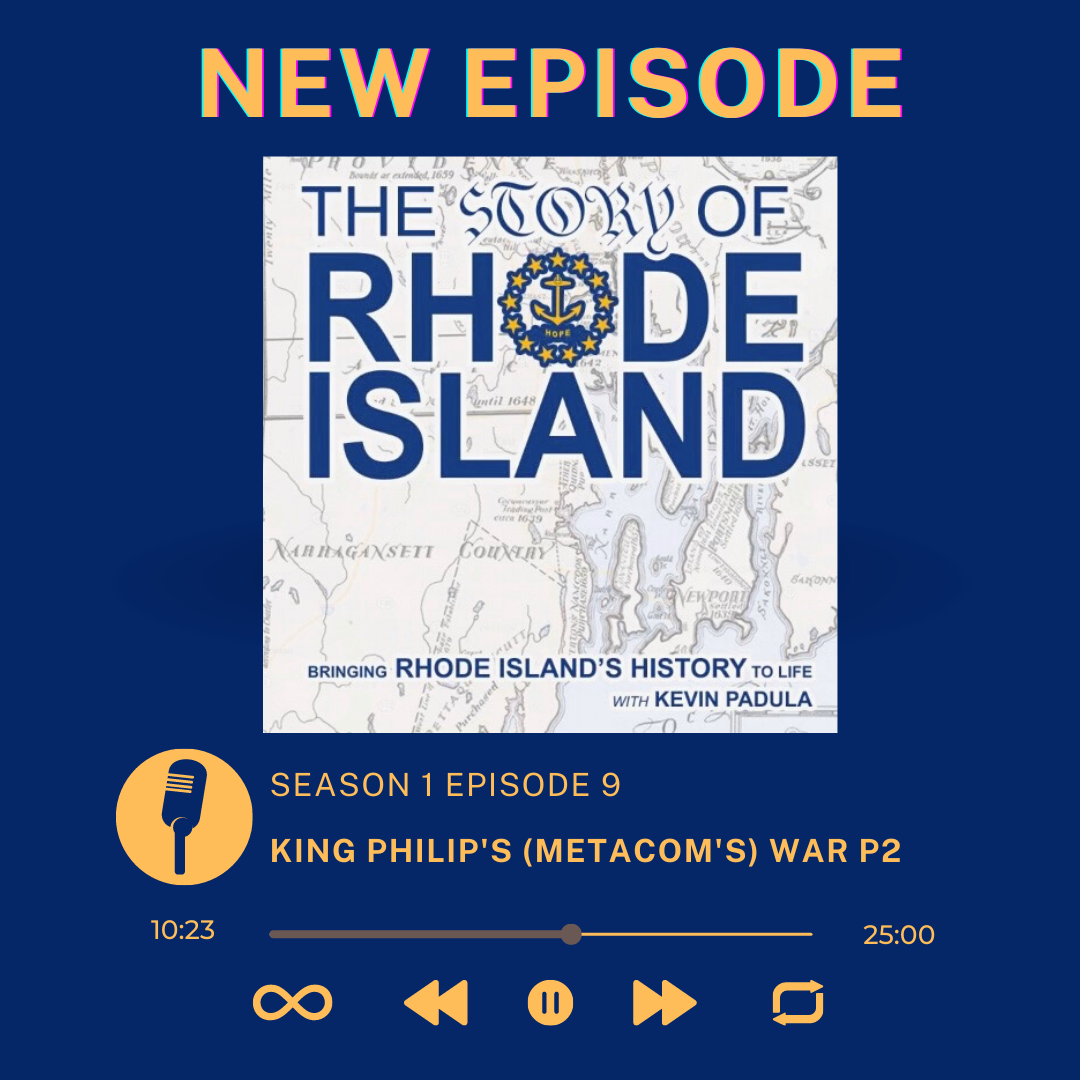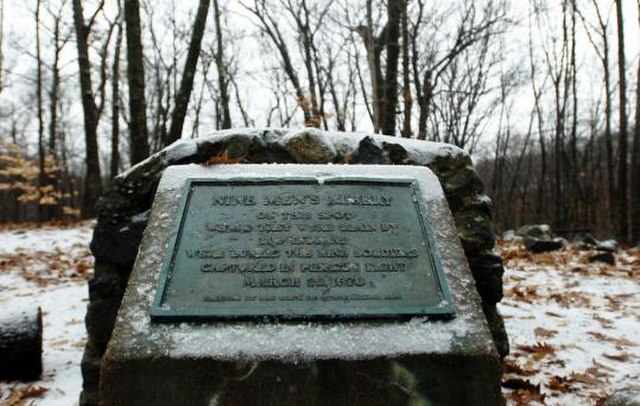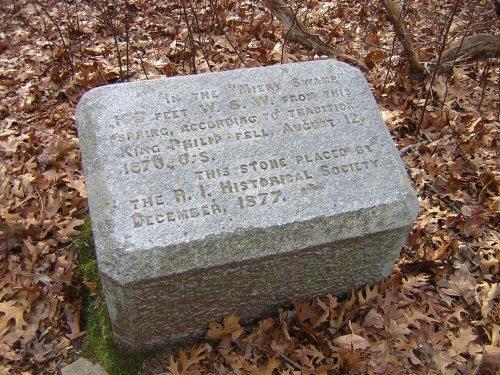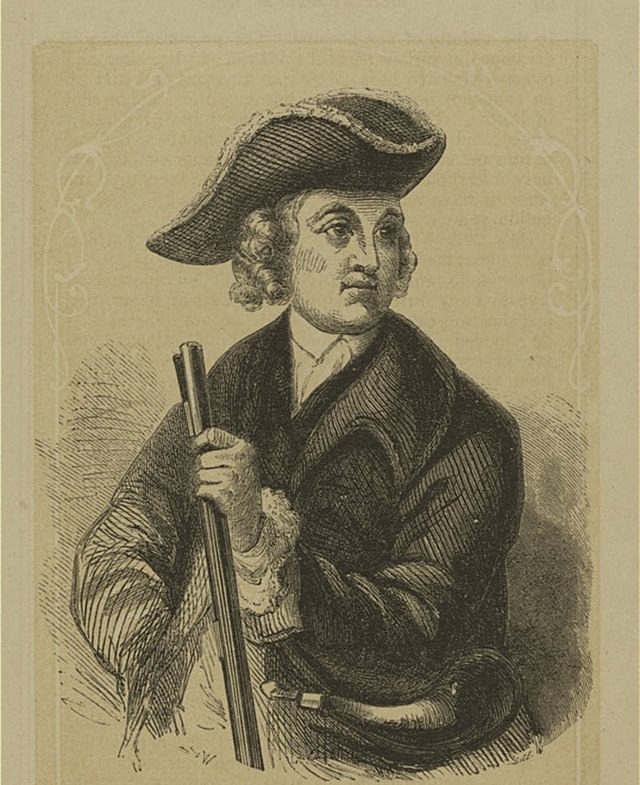After the Narragansett Nation enters King Philip's War and towns throughout Rhode Island are destroyed, the English colonists eventually find a way to defeat their formidable opponents.
28 minutes | 1675 - 1676
Hear About:
📜Canonchet and the Narragansett warriors' raids on the towns of Wickford, Warwick, Pawtuxet, Providence, and East Providence.
📜The downfall of the native warriors that eventually led to their demise.
📜How Benjamin Church helped to end King Philip's War

Anawan
One of King Philip's head military captains and a Pokanoket warrior who the English greatly feared. However, while the English colonists feared Anawan and the English soldiers despised him, Church respected his military expertise. After capturing Anawan, Church stayed up most of the night talking to him so that he could listen to the Pokanoket warriors war stories, once again proving how eager Church was to learn from his native opponents.
(Image credits: Photographed By Wikipedia's Xasartha, 10 April 2014)


Smith's Castle | North Kingstown, RI
In March of 1676, Canonchet and his warriors began destroying towns throughout the Rhode Island countryside. By the end of the month, Wickford, Warwick, Pawtuxet, Providence, and East Providence were all destroyed. One of the homes they burned to the ground was the trading post owned by Richard Smith Jr. which his father purchased from Roger Williams in 1651. The home was rebuilt in 1678 and because of its size it eventually became known as "Smith's Castle".

Nine Mens Misery | Cumberland, RI
In March of 1676, Captain Michael Pierce along with 60 English soldiers and about 20 friendly native warriors were searching for Canonchet in the woods of northern Rhode Island. The Narragansett Sachem used this as an opportunity to illustrate the superiority of his tribe's military tactics and quickly lured Pierce and his team into a trap. Then, his warriors ambushed them and killed pretty much all of them on the spot, both the English soldiers and the native warriors. However, not all died a quick death. 9 of Pierce's men were tortured and left in the woods. Today, the location where those men were found is known as Nine Mens Misery.
(Image credits: Photographed By Wikipedia's Swampyank, October 15, 2007)

King Philip's Death Site | Bristol, RI
In a "miery swamp" on Mount Hope sits a marker dedicated to the supposed location of where King Philip was killed by John Alderman, a Sub-Sachem who turned on Philip. Although the exact location of the Sachem's death will probably never be known, we do know that it took place somewhere on Mount Hope, the location where the Pokanoket's called home for thousands of years.
(Image credits: Photographed By Wikipedia's Swampyank, October 15, 2007)
.png)
Key Rhode Island Engagements of King Philip's War | 1675 - 1676
King Philip's War was extremely destructive to the Rhode Island Colony. From the summer of 1675 to Spring of 1676 hundreds of Native Americans & English were killed, hundreds of houses burnt to the ground, and many towns destroyed.
Timeline of Engagements:
- July 1675 - Almy's Pease Field Fight
- August 1675 - Nipsachuck Swamp Fight
- December 1676 - Two Narragansett villages destroyed, Jireh Bull Garrison destroyed, and hundreds of innocent Narragansetts are killed at the Great Swamp Massacre
- March 1676 - The towns of Wickford, Warwick, Pawtuxet, Providence, and Old Rehoboth (known as East Providence today) are destroyed. Then, over 50 English soldiers and several friendly natives are killed when Captain Pierce's men were ambushed in Central Falls, RI.
- August 1676 - King Philip is killed

In 1992, Benjamin Church was inducted into the Army Ranger Hall of Fame and is known as the "First Army Ranger"
While most English soldiers had no respect for their native opponents, the Little Compton native, Benjamin Church, knew that there was a lot he could learn from them. After capturing Anawan in August of 1676, Church stayed up most of the night talking with Anawan so that he could hear his war stories and the military tactics they used when fighting. His willingness to constantly advocate for the adoption of native military tactics played a pivotal role in popularizing their guerilla style warfare or as it was then known a "skulking way of war". Those tactics would eventually be used to help the Americans win key battles during the American Revolution. Overtime, those tactics evolved and would eventually be used by one of America's most elite military units, the United States Army Rangers. Church's contribution to this military unit were honored in 1992 when he was inducted into the Army Ranger Hall of Fame as the "First Army Ranger".- Roger Williams and the Creation of the American Soul: Church, State, and the Birth of Liberty by John M. Barry
- God, War, and Providence: The Epic Struggle of Roger Williams and the Narragansett Indians Against the Puritans of New England by James A. Warren
- Colonial Rhode Island: A history by Sydney V. James
- Rhode Island's Founders: From Settlement to Statehood by Patrick T. Conley
- Changes in the Land: Indians, Colonists, and the Ecology of New England by William Cronon
- Manitou and Providence: Indians, Europeans, and the Making of New England, 1500-1643 by Neal Salisbury
- Rhode Island: A History by William G. McLoughlin
- King Philip's War: The History and Legacy of America's Forgotten Conflict by Eric B. Schultz & Michael J. Tougias
- The Skulking Way of War: Technology and Tactics Among the New England Indians by Patrick M. Malone
- The Entertaining History of King Philip's War by Benjamin Church and Thomas Church